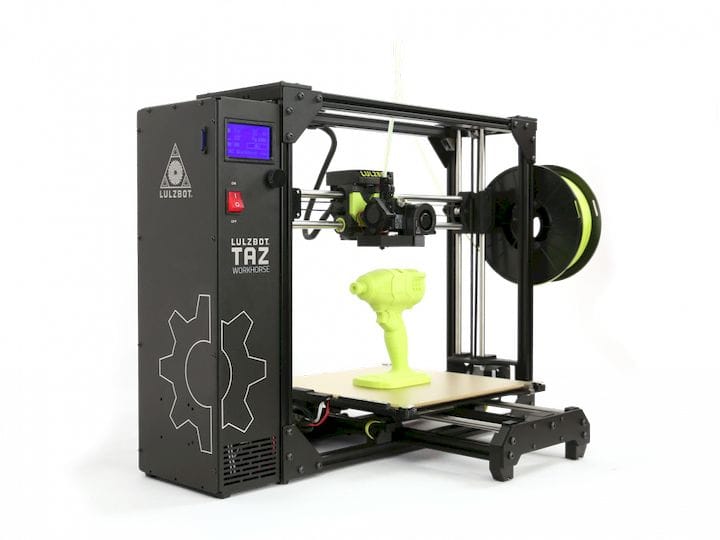![The TAZ Workhorse Edition professional desktop 3D printer [Source: Aleph Objects]](https://fabbaloo.com/wp-content/uploads/2020/05/image-asset_img_5eb0983b1a90f.jpg)
Aleph Objects announced a new professional desktop 3D printer, the LulzBot TAZ Workhorse Edition.
This device is improved upon its predecessor, the TAZ 6. What’s most surprising to me about this device is the naming: up to now, Aleph Objects has always used a numerical standard for their machine names, including the TAZ 4, TAZ 5 and TAZ 6 (and the new TAZ Pro). Everyone, and I mean everyone, was expecting to see the TAZ 7.
But no, it’s the TAZ Workhorse Edition. The name suggests the device is tuned for production purposes, but let’s take a look at the specifications to see what it can do.
The Workhorse Edition’s build volume is 14% larger than the previous TAZ 6, at 280 x 280 x 285 mm. That’s sufficiently large to enable printing of most common parts.
The extruder / hot end on the Workhorse is an all-metal Titan Aero from E3D-Online, a very capable component. It’s able to hit a maximum temperature of 290C, and can heat up to 230C in only 96 seconds.
The print surface on the Workhorse is also heated, as its predecessors’ have been. This surface is able to hit as high as 120C, and takes just over 10 minutes to get to 100C, suitable for ABS printing. Aleph Objects says:
“Printing with a wide range of materials, including high-heat and high-strength composite polymers, is now possible straight out of the box with hardened-steel tool head components.”
Specifically, Aleph Objects has certified printing of: PLA, ABS, Nylon 645, Polycarbonate, Carbon Fiber Reinforced Blends, TPU 85A and 95A, PETG, PETT, Copolyester, PVB, HIPS, and “many more”. That’s a very reasonable set of engineering-grade materials for this device. I should mention that the Workhorse, like all LulzBot equipment, uses 2.85mm filament instead of the more commonly used 1.75mm filament diameter.
They’ve also re-worked the cooling vent system to allow for 360 degree cooling. This is quite important, as on larger prints the cooled air from uni-directional configurations doesn’t make it around to the far side and thus one side of the prints could appear sloppy. This new feature should ensure uniform quality on all sides of Workhorse prints.
The print head allows for swapping in nozzles of different diameters. A small 0.25mm nozzle can be used for fine details, while the 0.8mm and monstrously huge 1.2mm nozzles can dramatically speed up printing when fine details are not required.
Another change on the device is a belt-driven Z-axis, something rarely seen. Most 3D printers use a threaded-rod system. The belt system should allow the bed to be raised faster and more accurately. I believe the idea here is to speed up the printer, as there are some other tweaks that seem to follow the same strategy.
[UPDATE] Reader Erik points out that one of the LulzBot Family, the Mini 2, also uses a belt driven Z-axis:
“Although other Lulzbot printers may use the threaded rod system the Mini 2 uses a belt drive system for the Z axis which was one of the main reasons I purchased the printer. It’s very quiet and repeatedly accurate printer that shares some of the features of the Workhorse and in my humble opinion is a greatly underestimated printer.”
One of them is a new “automatic X/Y/Z backlash compensation” system. Backlash is something that happens more frequently when the machine is moving at higher speeds. Similarly, a more rigid frame should help dissipate the vibrations from rapid movements that could corrupt print quality.
Aleph Objects says the device will be shipping in June of this year, and they’ve set the price for the unit at US$2,950.
Via LulzBot











FELIXprinters has released a new bioprinter, the FELIX BIOprinter, which is quite a change for the long-time 3D printer manufacturer.